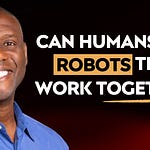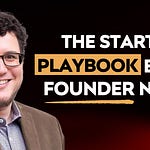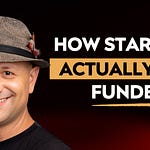What if the most compelling investment strategy wasn’t just about returns—but about building the infrastructure for humanity’s future?
In our latest episode of The Ignite Podcast, we sat down with Abdo John Hajj, Managing Partner at Type One Ventures, a deep tech investor who’s helped deploy over $1 billion across transformational companies like SpaceX, OpenAI, Neuralink, and Plaid. But even if you don’t listen to the episode, his story and thesis are worth diving into.
From Film to Frontier Tech
Abdo’s path to venture isn’t typical. Raised in Burbank, California—the heart of Hollywood—he began his career in film production. But he quickly realized he was more drawn to the business and strategic side of storytelling than the glitz of entertainment. That instinct to back great narratives eventually led him to technology, entrepreneurship, and ultimately, investing.
He co-founded a startup at USC, pivoted into private equity, and found himself drawn to industrial innovation. He saw firsthand how outdated and inefficient many legacy systems were, and he became obsessed with the idea of building better—from the ground up.
The Type One Thesis
So what exactly is a “Type One Civilization”?
The term comes from the Kardashev scale, a method for measuring a civilization's technological advancement based on energy consumption. A Type One Civilization can harness all the energy available on its home planet in a sustainable way.
According to Abdo, we’re currently around 0.72 on that scale. His mission? Help accelerate our progress to 1.0—through bold, long-term investments in the most foundational and transformational technologies of our time.
How to Back the Future (and Stay Grounded)
Abdo and his team translate this 100+ year vision into 5–10 year actionable investment strategies. They break complex, long-horizon goals into digestible milestones—asking questions like:
What catalyst technologies do we need in the next 5 years?
How can we invest in infrastructure that supports space colonization?
What AI and quantum breakthroughs will unlock new levels of productivity and discovery?
To do this, Type One Ventures operates across stages—early, growth, and special purpose vehicles (SPVs)—and uses a custom-built framework to weigh technical, market, and team risk before deploying capital.
The Convergence: AI, Space, Quantum, and Infrastructure
Abdo believes the future won’t be built by AI alone—it will emerge at the intersection of technologies. Picture this:
Space-enabled infrastructure powered by artificial gravity
Quantum-powered compute running next-generation AI models
Advanced materials, like graphene fiber, shaping next-gen manufacturing
He calls this convergence “a platform shift” — and likens its impact to the arrival of the internet or smartphones.
A Tesla of Housing?
One standout in Type One’s portfolio is Cuby, a company building deployable microfactories that construct affordable, high-quality homes at sub-$90/sq ft. The idea? Ship the raw materials to a portable factory (housed in containers), build locally, and reduce logistical inefficiencies and regulatory delays.
Abdo believes Cuby could be “a Tesla-like outcome”—a company that fundamentally rewires how we think about shelter and infrastructure.
Thoughts on AI Safety and Risk
Despite backing OpenAI and Neuralink, Abdo holds a clear-eyed view on AI’s risks and promise. He argues:
“Humans are still more dangerous than AI. Our irrationality, not the tech itself, poses the greatest threat.”
He’s cautiously optimistic about a “gentle singularity”—a slower, more manageable transition to a world where AI is deeply integrated into our lives. Still, he emphasizes the importance of guardrails, thoughtful regulation, and diversification of development.
What's Next
Looking ahead, Type One Ventures is placing major bets on quantum computing, lunar infrastructure, and space-based manufacturing. They're also experimenting with creative fund structures to better align with LP expectations around liquidity and optionality.
Abdo’s long view? Don’t just invest in what’s trending. Invest in what gets us to a civilization that survives—and thrives—for generations to come.
Final Thoughts
You don’t need to be a sci-fi nerd or a venture capitalist to appreciate Abdo John Hajj’s vision. It’s about more than startups or technology—it’s about what kind of future we want to live in, and how we build the systems to support it.
👂🎧 Watch, listen, and follow on your favorite platform: https://tr.ee/S2ayrbx_fL
🙏 Join the conversation on your favorite social network: https://linktr.ee/theignitepodcast
Chapters:
00:01 – Welcome and guest intro: Abdo John Hajj of Type One Ventures
01:00 – Star Wars vs. Star Trek: The power of timeless storytelling
02:22 – What is a Type One Civilization? (Kardashev Scale explained)
04:22 – Translating a 150-year vision into 10-year investment strategies
06:36 – From LA film production to deep tech investing
08:42 – Building a startup to disrupt content and pivoting to venture
10:57 – Industrial inefficiencies and spotting legacy disruption opportunities
12:15 – Convergence of AI, space, quantum, and advanced materials
14:18 – Rethinking the venture fund model and building for long-term innovation
15:07 – The case for product innovation in venture capital
18:14 – Why deep tech VC requires multi-stage capital and conviction
21:40 – Mapping 3–15 year tech timelines and exposure limits
23:56 – Catalyst moments in space and AI (ChatGPT as the iPhone moment)
25:01 – Early-stage vs. growth investments and market mapping strategy
26:42 – Investing in artificial gravity and modular space stations
29:55 – Family, kids, and raising the next generation of sci-fi lovers
31:28 – How Type One Ventures evaluates risk with the “prism” framework
33:45 – The challenge of knowing when to walk away
35:17 – Why hardware investing is hard—and worth it
37:12 – AI eating services: Professional labor replaced by agents
39:00 – Real-world AI examples: Using Operator for a pool party
41:12 – Cuby: Microfactories for housing at $90/sq ft
43:44 – Solving construction inefficiencies and regulation pain
45:57 – What capital efficiency looks like in deep tech
47:09 – Building teams with a few great engineers, not just many
48:33 – Why Cuby could be a Tesla-scale outcome
49:58 – Investor optionality, DPI, and what LPs actually want
53:00 – AI safety, the “gentle singularity,” and why people are the risk
56:48 – Investing in Neuralink and brain-computer interface
58:07 – Uploading cognition, Kurzweil, and the future of merging with AI
01:02:05 – What’s next: Quantum computing, lunar infrastructure, Mars
01:04:31 – Financial innovation to serve both founders and LPs
01:05:03 – LPs want optionality more than liquidity










